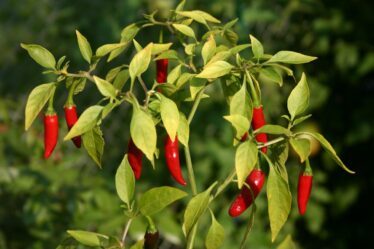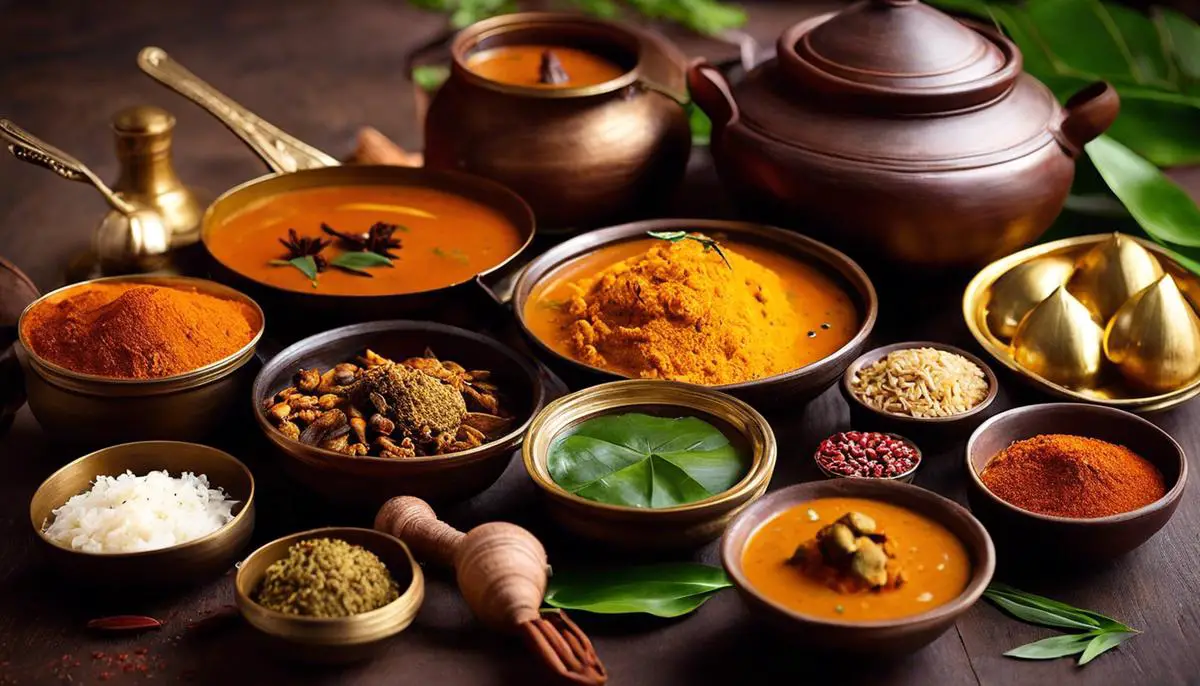
At the heart of South Indian cuisine lies an aromatic treasure that evokes a zest for tradition on the palate—Kaara Kozhambu. This hearty stew embodies the rich culinary heritage of a region famed for its bold and complex flavors. Tracing the origins of Kaara Kozhambu is like embarking on a flavorful journey through time, where each simmering pot is a testament to the diverse cooking practices rooted in the diverse landscapes of South India. The immense popularity of Kaara Kozhambu stems not just from its piquant notes but also from the adaptability of its recipe, which welcomes a spectrum of local ingredients, infusing the stew with regional characteristics and beloved family traditions.
The Origins of Kaara Kozhambu
Unraveling the Spicy and Tangy Mystique of Kaara Kozhambu – a South Indian Staple
Ah, Kaara Kozhambu! It’s the kind of dish that can make you feel like you’re basking in the warmth of a South Indian kitchen, no matter where you are. Its tangy, spicy flavors are enough to tantalize even the most discerning taste buds. This culinary gem has woven itself into the fabric of South Indian cuisine and culture for reasons that are as delicious as the dish itself.
Originating from the southern states of India, particularly Tamil Nadu, Kaara Kozhambu (also spelled as Kara Kuzhambu) literally translates to ‘spicy gravy’. The name alone is enough to make a food lover’s heart beat faster. Made from a delectable concoction of tamarind, native spices, and a mix of vegetables or sometimes fish, this dish holds the secrets of ancient culinary practices that have stood the test of time.
So, how did Kaara Kozhambu rise to the level of culinary staple in South India? The answer lies in its versatility and depth of flavor that brings any meal to life. In a region where rice is a mainstay, Kaara Kozhambu serves as the perfect accompaniment, with its bold flavors cutting through the blandness of the staple grain. The marriage of sourness from the tamarind, heat from the red chilli powder, and a slight bitterness from fenugreek seeds is nothing short of a taste sensation.
Another key to Kaara Kozhambu’s enduring popularity is its adaptability. The dish welcomes a range of ingredients from eggplant and okra to fish, allowing it to cater to a spectrum of palates and preferences. It’s quite the socialite – blending with and complementing other dishes at the South Indian table.
Moreover, the process of preparation itself mirrors the traditional South Indian cooking techniques. The tempered spices, known as tadka, prepared with mustard seeds, curry leaves, and asafoetida, are skillfully poured into the simmering gravy, creating an aromatic infusion that is characteristic of regional cuisine. The technique is as much a feast for the senses as the eating – the sizzle as the tadka hits the gravy, the aroma that fills the air, and the vibrant colors that promise a meal both hearty and comforting.
What truly cements its status is the ability to bring people together. Kaara Kozhambu is often the centerpiece at gatherings, served lovingly alongside fluffy idlis, crispy dosas, or steaming hot rice, embracing the ethos that food isn’t just nutrition, it’s a connection; a shared experience that binds families and friends together.
The real beauty of Kaara Kozhambu lies in its profound simplicity, yet complex interplay of flavors. It captures the essence of South Indian cuisine – bold, unapologetic, and bursting with life. It’s a dish that doesn’t just feed the body but also nourishes the soul, reminding us why food is indeed the greatest of all cultural unifiers. From humble kitchens to bustling restaurants, Kaara Kozhambu continues to be a beloved treasure, a testament to the rich culinary heritage of South India. And there you have it – the fiery yet comforting embrace of this exquisite dish has made it an irreplaceable staple for food lovers in South India and beyond.
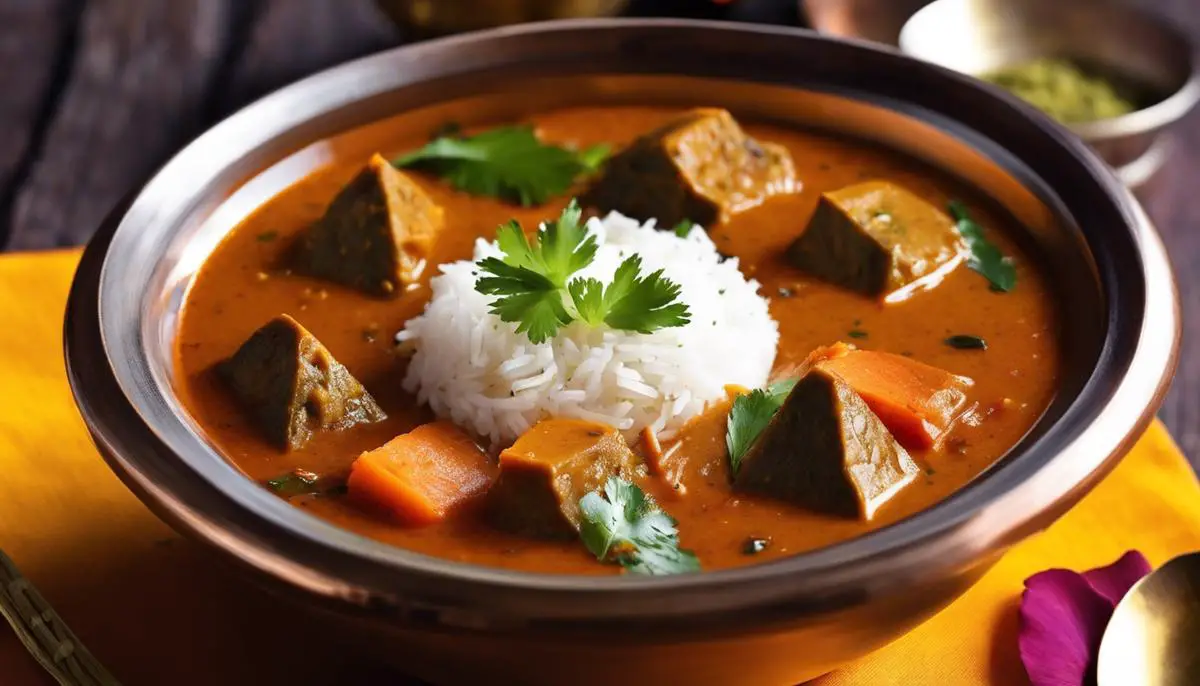
Fundamentals of Cooking Kaara Kozhambu
An Authentic Kaara Kozhambu: Balancing the Heat and the Tang
Firing up the stove for an authentic Kaara Kozhambu, one must remember that it’s not just about tossing in chillies for heat but about creating a harmony between spice and tang. The soul of this dish lies in the delicate balance of its essential ingredients: tamarind pulp and a tailored spice blend.
First, let’s talk tamarind. This isn’t just any souring agent; it’s the backbone of Kaara Kozhambu. It adds depth and a slight fruity undertone that’s indispensable. For the real deal, choose fresh, pulpy tamarind and soak it to create a rich extract. The quality and freshness of your tamarind can make or break your Kozhambu, so this step is non-negotiable.
Now to the fiery side – the spice blend. While quality pre-made sambhar powders can work, for an authentic touch, grinding spices at home is the secret. The combination can include coriander, cumin, fenugreek, black pepper, mustard seeds, and dry red chilies. These spices should be pan-roasted to awaken their essential oils, then ground to a fine consistency. This is where the magic is infused. The dedication to creating your spice blend pays off with each mouthwatering spoonful.
Timing in the kitchen is also crucial. When heating oil, adding mustard seeds, and waiting for that satisfying crackle, one can’t rush the process or risk under-extracting the flavors. The addition of aromatic curry leaves and shallots is a dance of timing, ensuring they’re cooked to the point where they release their maximum aroma without getting lost in the simmering sauce.
Furthermore, do not underestimate the importance of the right type of oil. Sesame oil, traditional in Southern kitchens, imparts a distinct nutty taste that elevates the Kozhambu’s flavor profile. This isn’t just any oil; it’s liquid gold in the context of South Indian cooking.
Then there’s the question of consistency. Too thick, and it doesn’t mingle well with the accompaniments; too thin, and the flavors are diluted. The perfect Kaara Kozhambu coats the back of a spoon with its rich, velvety sauce, seducing the palate before it even reaches the mouth.
Last but not least, patience is an essential component, allowing the dish to simmer and thicken, letting every ingredient mingle and marry into a crescendo of flavors. A hurried Kozhambu is like an unfinished symphony; it may have all the right notes, but it lacks the depth that time coaxes forth.
Crafting an authentic Kaara Kozhambu is like painting with flavors; each stroke is a spice, tamarind’s sourness is the canvas, and culinary patience is the brush. It’s the celebration of tradition and an ode to the sensory tapestry of South India’s compelling cuisine. Ensure these essentials are given their due respect, and the Kozhambu will be nothing short of divine.
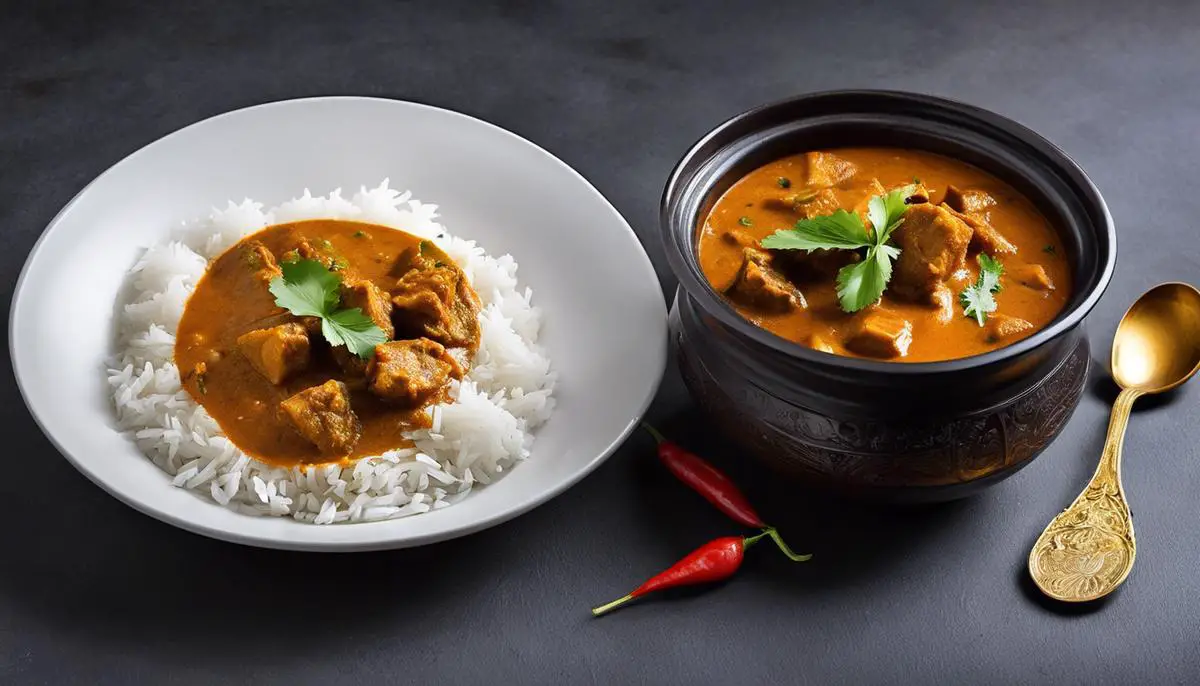
Variations of Kaara Kozhambu
Customizing Kaara Kozhambu to Dance on Your Taste Buds
Ah, the Kaara Kozhambu—this South Indian marvel can jazz up any meal with its rich, tangy, and spicy symphony. But here’s the catch, it’s not just a single tune; it’s a whole genre of flavors waiting to be personalized! Customizing Kaara Kozhambu isn’t just about following tradition; it’s about infusing your narrative into each simmering pot.
Ready to put a twist on tradition? Introduce veggies to elevate the nutritional profile and add new dimensions of taste. Eggplants, drumsticks, and okra bask luxuriously in the tamarind-tangy broth, absorbing all the zesty goodness. Or, for a sweeter note, pop in some pumpkin or sweet potato—these root vegetables bring a gentle sweetness balancing the piquancy.
Let’s chat proteins. This sauce welcomes all—from succulent fish to tender chicken chunks, transforming the humble Kozhambu into a robust meal. For plant-based pals, chickpeas or lentils offer a hearty bite and make it an all-rounder that pleases every palate.
Spice fanatics, why not amplify the heat? Toss in a couple more dried red chilies or a spoon of peppercorns and get those taste buds buzzing. Or for a smoky layer, a hint of roasted spices will do the trick. And those who dare to dabble in the sour world, go wild with extra tamarind or maybe a splash of vinegar for a funky beat.
Whisk in a dollop of jaggery or sugar for those tender-hearted. It’s okay to admit it; a little sweetness makes everything better. A spoonful rounds out the flavors, offering a harmonious finish that lingers longingly on the tongue.
Now, about that silky, luscious texture—coconut milk slips into the mix, yielding a creamier and richer sauce that’s utterly luscious. And for the oil? Sure, sesame oil is king, but why not try coconut oil for a fragrant twist or ghee for a nutty undertone? Experimenting is the game!
Do consider the timing of spice additions. In the first sizzle of oil, releasing mustard seeds and curry leaves is merely the appetizer. As you progress, layer the spices and simmer to new heights of flavor melding. And always remember, the longer the Kozhambu simmers, the deeper and more complex the flavors become—a testament to the adage “patience is a virtue.”
Tailoring Kaara Kozhambu to suit your fancy doesn’t just craft a dish—it weaves a story of tastes and textures unique to each kitchen. Dive into the adventure; after all, the joy of cooking is in the creations that emerge from the melding of tradition, innovation, and the love of good food. Bon appétit, or as you’d hear in the markets of Chennai, “Saptiya!”
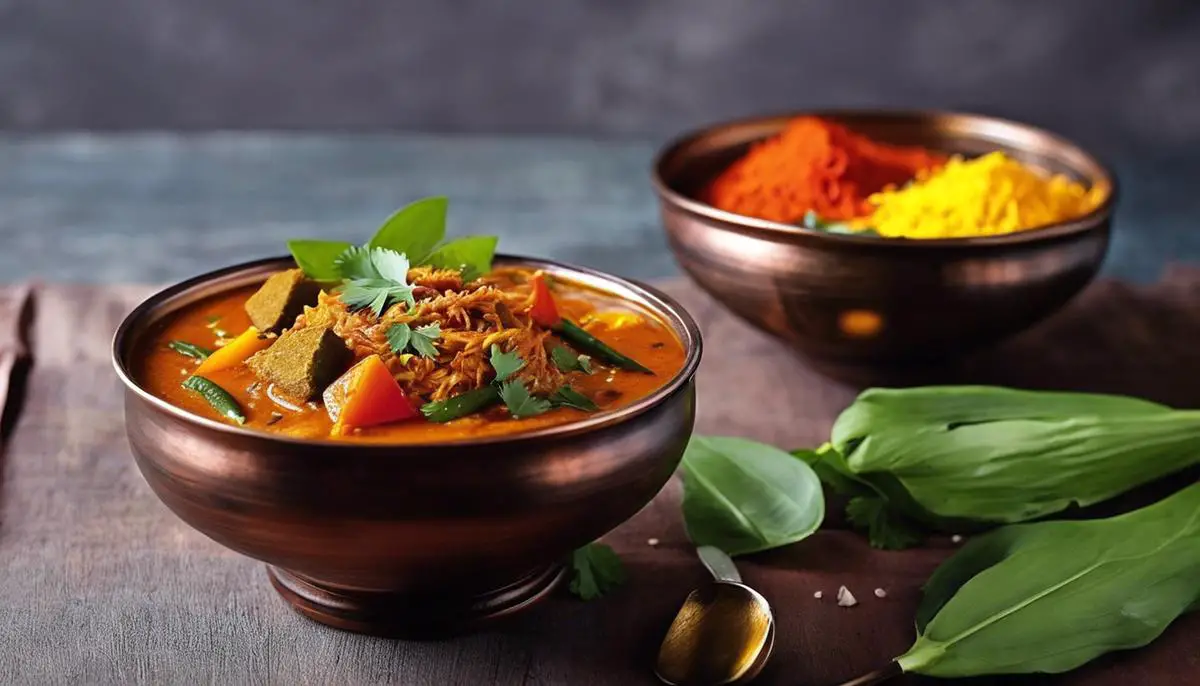
Pairing with Kaara Kozhambu
Elevating the Intensity: Perfect Pairings for Kaara Kozhambu
Embark on a flavor journey where the robust tastiness of Kaara Kozhambu takes the spotlight. This South Indian delicacy, teeming with tamarind tartness and a symphony of spices, beckons for the right accompaniments to elevate its intensity to delightful new heights.
For palates seeking harmony, nothing complements the tangy zest of Kaara Kozhambu like the soothing presence of a well-cooked basmati or jasmine rice. The fragrant grains act as a canvas, accentuating the rich sauce’s explosive flavors without overwhelming the senses.
When contemplating textures, consider the pillowy softness of idlis or the crispiness of dosas. These traditional South Indian staples not only balance the dish but also add a dimension of tactile pleasure that pairs impeccably with the hearty consistency of Kaara Kozhambu.
Coolness amidst spice is always welcome, and a dollop of creamy, cooling raita or a chilled bowl of cucumber pachadi can provide a restful contrast to the warmth pervading the palate. The cucumber’s crunch and the yogurt’s fresh tang are a refuge for taste buds dancing in the heat of Kaara Kozhambu’s embrace.
Explorers of culinary landscapes should not overlook the potential of adding a side of pickled vegetables or a mildly spicy chutney. These condiments, with their own sharpness and depth, have a natural affinity for the Kaara Kozhambu, their complex notes mingling with the sauce in a celebratory feast of flavors.
And for an untraditional twist that’ll make taste buds sing, consider a fresh, citrusy salad sprinkled with a dash of salt and pepper. The lightness of the greens and the bursts of citrus cut through the deep savory tones of Kaara Kozhambu, creating a refreshing interplay that’s hard to resist.
Kaara Kozhambu summons the artist within each chef, inviting an exploration of flavors and companions that amplify its essence. Whether one leans towards traditional pairings or adventurous culinary fusions, the joy of crafting the perfect combination to complement Kaara Kozhambu lies in the freedom to experiment. Therein is the artistry of food – a colorful palette that connects us all through shared tastes and experiences, one delectable meal at a time.

Modern Twists to Traditional Kaara Kozhambu
Elevating Tradition: Modern Twists on Classic Kaara Kozhambu
A bold symphony of spices, the beloved Kaara Kozhambu, is revered for its deep roots in South Indian kitchens. But, for those culinary adventurers constantly on the hunt for exciting taste bud challenges, dare we add a contemporary zing to this classic? Absolutely!
Imagine infusing global influences into Kaara Kozhambu while preserving its authentic soul. The stage is set for fusing East with West, old with new, tradition with innovation. Let’s explore the unexplored!
Start by swapping the conventional basmati or jasmine rice with nutty, chewy ancient grains like quinoa or farro. These grains not only bring a delightful textural contrast but pack a nutritional punch, making the meal both wholesome and exotic.
Steer towards the accompaniments – why not try soft idlis or crisp dosas with a modern makeover? Add a dash of fusion by folding finely chopped spinach and a hint of garlic into the batter. You’ll witness an astonishing blend of colors and extra layers of flavor that refresh these staple sides.
Moving onto raita or cucumber pachadi, acidity and coolness can be intermingled with sweet and spicy elements. Infuse the yogurt with a spoonful of honey and a sprinkle of pomegranate arils for a surprising burst of sweetness and a pop of color that’s as pleasing to the eye as it is to the palate.
Next in line – pickled vegetables or spicy chutney. Transform these classics by incorporating unexpected vegetables like beets or carrots, or fruits such as mango and fig. Boost the chutney with a hint of international flavors — perhaps a Moroccan ras el hanout or Mexican chipotle can add an unforeseen but welcome twist.
Let’s not ignore the allure of a fresh, citrusy salad accompanying the bold Kozhambu. Incorporate bitter greens like arugula or endive, toss in some ruby red grapefruit segments, and sprinkle with toasted almonds for an intercontinental carousel of flavor.
And finally, the pièce de résistance, the Kaara Kozhambu itself — can one tweak the untweakable? Without a smidgen of doubt! Enrich the dish with umami-packed sundried tomatoes, a handful of olives, or capers adding little salty bursts that contrast the tangy tamarind. Or explore the use of unconventional proteins such as tempeh or seitan for a modern vegetarian feast.
Surely, the heart and essence of Kaara Kozhambu must remain untouched, but by integrating these contemporary touches, we build bridges between cultures on our plates. At the end of the day, food is a universal language that knows no bounds, growing richer with each new flavor and technique we embrace.
So whip out the pots and pans, and beckon the new while cherishing the old. In this bustling culinary landscape, let tradition meet trend. After all, the best meals aren’t just made—they’re crafted with audacity and served with a side of ingenuity.

Sharing and Enjoying Kaara Kozhambu
Kaara Kozhambu: A Culinary Odyssey Connecting Tradition and Innovation
Within the aromatic kitchens of South India, Kaara Kozhambu stands as a testament to culinary endurance, bridging generations through its robust flavors. Yet, beyond tradition, its true beauty lies in its evolution, as modern epicureans infuse contemporary twists into this beloved staple, showcasing its ability to transcend the borders of time and geography.
One starts to wonder, how can one elevate the already divine experience of dipping fluffy idlis into this tangy, spicy gravy? Imagine infusing the idli batter with a puree of beetroot or carrot, giving a burst of color and subtle sweetness that contrasts magnificently with the spiciness of Kaara Kozhambu.
Adventurous chefs might experiment with the grain base that accompanies Kaara Kozhambu. Why not swap white rice for nutty, textured grains like quinoa or farro? These grains not only add a delightful crunch but also actively absorb the flavors of the gravy, releasing them slowly with each bite.
The collaborative spirit of Kaara Kozhambu implores one to play with the side dishes as well. Raita or cucumber pachadi are ripe for innovation. A dollop of natural honey, a sprinkle of bright pomegranate seeds, or a dash of aromatic mint can transform these cool companions into a refreshing fusion of flavors, bridging the gap between old and new.
When it comes to pickles and chutneys, there’s an entire palette to play with. The sweetness of mango or the earthy tones of roasted beets make for intriguing pickles juxtaposing the Kaara Kozhambu’s heat. Chutneys can embark on a wild ride with ingredients like velvety figs and zesty oranges, creating a whirlwind of taste that dances on the palate.
Moreover, consider reinventing the salad course by tossing dark, bitter greens with sliced grapefruit or orange, drizzled with a citrus vinaigrette, topped with a handful of toasted almonds or walnuts for that extra oomph.
The courage to innovate also means reimagining the main star of the show. Kaara Kozhambu itself could see a new era, enhanced with sundried tomatoes, mediterranean olives, salty capers, or even unconventional proteins such as nutty tempeh or wheat-based seitan creating a symphony that reverberates with authenticity yet sings in a modern tone.
Ultimately, as culinary boundaries are stretched and molded, regardless of the adaptations or the creative liberties taken with Kaara Kozhambu, it’s crucial to keep the heart and essence of the dish intact. This balance pays homage to heritage while bravely stepping into the new age, a satisfying blend of respect and rebellion.
Food, at its core, is a universal language that knows no barriers, connecting people through shared experiences, flavors, and techniques. By embracing the spirit of Kaara Kozhambu—a carrier of culture and culinary joys—one participates not merely in the act of eating but in the collective endeavor of taste and togetherness. The magic of this dish is not only in its power to sate our hunger but also in its endless capacity to unite and inspire across cultures, tastes, and times.

The cherished practice of gathering around a steaming bowl of Kaara Kozhambu transcends the act of mere consumption, turning meals into momentous occasions that forge connections and celebrate communal spirit. This iconic dish stands as a beacon of South Indian gastronomy, a captivating blend of tangy, spicy, and savory notes that echo in the laughter and conversations around dining tables. From its humble origins to the innovative variants gracing contemporary menus, Kaara Kozhambu remains an enduring narrative of tradition and creativity, a culinary hymn sung in homes and restaurants alike that invites both the old and the new to partake in its storied and flavor-filled history.

